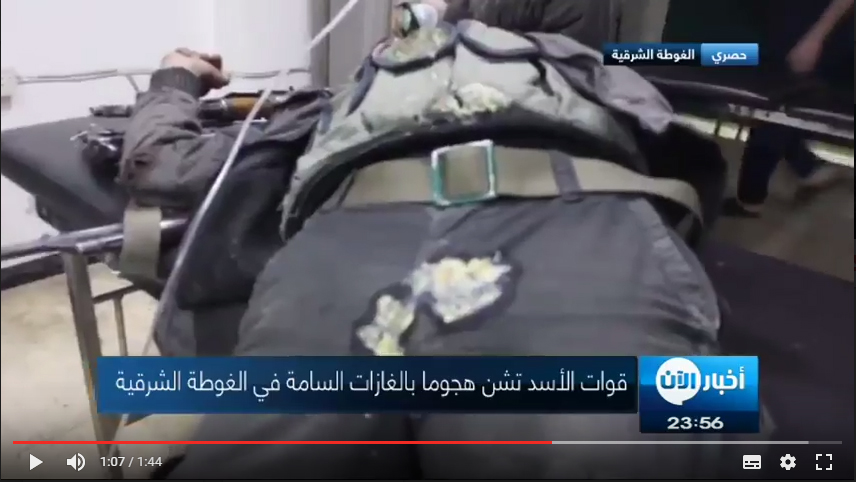On April 22, 2017, Syrians for Truth and Justice (STJ) received news that Syrian military forces reiterated the use of poisonous chemicals in one of the clashes points with armed opposition forces, Failaq al-Rahman, Syrians for Truth and Justice reporter in Eastern Ghouta said after interviewing many people who were exposure to the gas, in addition to medical staff who came for help.
Jawad al-Arbiny, “Al Aan TV” reporter, told Syrians for Truth and Justice that soon after he heard about the attack, he headed to the medical center that received the injured and noticed some symptoms manifested on them like respiratory distress and vomiting, the injuries varied in severity.
In a testimony to Syrians for Truth and Justice, Dr. Hamza, who was there at the same medical center, said the incident occurred on Saturday evening, April 22, 2017 in Zamalka area, west of Erbeen area. Hamza added,
“Victims, who were military elements from the armed opposition forces, were transferred to the Zamalka hospital. Given the blowing of the west wind in Eastern Ghouta, where Erbeen is near Zamalka, other people were injured in Erbeen as well because the wind dispersed the gas. One of the cases there needed treatment, and I contacted the hospital that received other injured people to enquire about the symptoms demonstrated on the victims.”
Regarding the symptoms, Dr. Hamza said,
“The symptoms demonstrated were: conjunctivitis, respiratory distress, slow in heartbeats and lack of oxygen. The pulse of one of the injured was 48. Another one told me that he became unconscious following the attack. We gave them the atropine. Others said they smelled stench accompanied the attack.”
Dr. Hamza suspects that the gas used was neither chlorine nor Sarine; it was not the gas of normal explosions. As he explains the gas associated with normal explosions does not move from area to area because of the wind neither the patients need to go to hospitals. This time the gas seemed to be toxic. Due to lack of ‘toxicology laboratories’ and the inability to take samples to send them out of Syria given the blockade imposed on the region, all the doctors in that area cannot define the type of the gas used very accurately. Hamza thinks that the Syrian military is experimenting new gases by using this type of gas. However, they are poisonous gases.
A video tape published by (Al Aan TV) shows an injured who manifested detachments out of the mouth.

An image taken from a video tape released by (Al Aan TV) reporter
A combatant affiliated to armed opposition forces (Failaq al-Rahman) said in his testimony that the attack occurred at about 8:00pm with anti-personnel hand grenades, he added,
“While other combatants and I were in the checkpoint that separates Zamalka and Erbeen from the side of (Department of the General Intelligence), I counted up to twenty hand grenades in the attack. After that, clashes started between armed forces and the regime forces that attempted to sneak closer to us. Moments later, we started to feel respiratory distress, fatigue, and some of us were vomiting.”
Syrians for Truth and Justice (STJ) and Justice for Life Organization released a broad report about the attack on Khan Sheikhoun on April 4, 2017, Idlib province. The report concludes that the Syrian war aircrafts were responsible for the crime and claimed the death of more than (103) and wounded more than (450) in the second in scale to only the chemical attack on Eastern Ghouta in the Damascus countryside and al-M’adamya on August 21, 2013.

